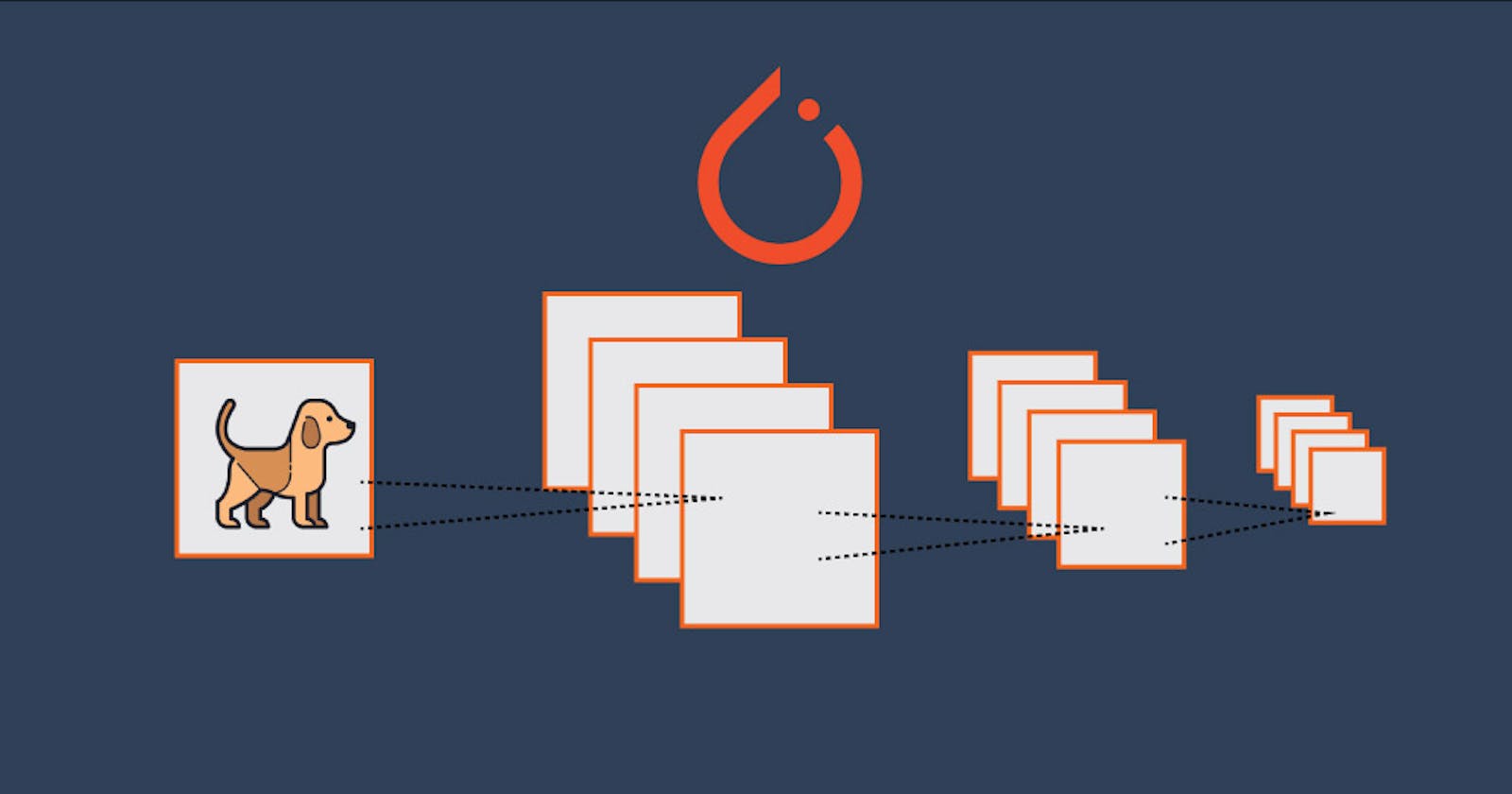In this article, we will learn about using CNNs in PyTorch. We will use the standard CIFAR10 dataset and perform image classification on it.
Importing Libraries
import torch
import matplotlib.pyplot as plt
import numpy as np
Data loading
import torchvision
import torchvision.transforms as transforms
trainset = torchvision.datasets.CIFAR10(root='./data', train=True,
download=True,
transform=transforms.ToTensor())
Output:
Files already downloaded and verified
classes = ('plane', 'car', 'bird', 'cat', 'deer', 'dog', 'frog', 'horse', 'ship', 'truck')
trainloader = torch.utils.data.DataLoader(trainset, batch_size=4, shuffle=True)
dataiter = iter(trainloader)
images, labels = dataiter.next()
print(images.shape)
print(images[1].shape)
print(labels[1].item())
Output:
torch.Size([4, 3, 32, 32])
torch.Size([3, 32, 32])
0
Visualise data
img = images[1]
print(type(img))
Output:
<class 'torch.Tensor'>
npimg = img.numpy()
print(npimg.shape)
Output:
(3, 32, 32)
npimg = np.transpose(npimg, (1, 2, 0))
print(npimg.shape)
Output:
(32, 32, 3)
plt.figure(figsize = (1,1))
plt.imshow(npimg)
plt.show()
Output:

def imshow(img):
npimg = img.numpy()
plt.imshow(np.transpose(npimg, (1, 2, 0)))
plt.show()
imshow(torchvision.utils.make_grid(images))
print(' '.join(classes[labels[j]] for j in range(4)))
Output:

ship plane ship ship
Single Convolutional Layer
import torch.nn as nn
class FirstCNN(nn.Module):
def __init__(self):
super(FirstCNN, self).__init__()
self.conv1 = nn.Conv2d(3, 16, 3, padding=(1,1), stride=(2,2)) # padding=(1,1), stride=(2,2))
def forward(self, x):
x = self.conv1(x)
return x
net = FirstCNN()
out = net(images)
out.shape
Output:
torch.Size([4, 16, 16, 16])
for param in net.parameters():
print(param.shape)
Output:
torch.Size([16, 3, 3, 3])
torch.Size([16])
out1 = out[0, 0, :, :].detach().numpy()
print(out1.shape)
Output:
(30, 30)
plt.imshow(out[0, 0, :, :].detach().numpy())
plt.show()
Output:
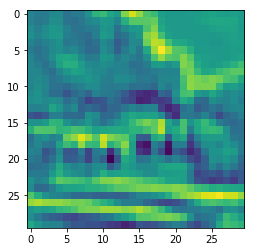
Deep Convolutional Network
class FirstCNN_v2(nn.Module):
def __init__(self):
super(FirstCNN_v2, self).__init__()
self.model = nn.Sequential(
nn.Conv2d(3, 8, 3), # (N, 3, 32, 32) -> (N, 8, 30, 30)
nn.Conv2d(8, 16, 3) # (N, 8, 30, 30) -> (N, 16, 28, 28)
)
def forward(self, x):
x = self.model(x)
return x
net = FirstCNN_v2()
out = net(images)
out.shape
Output:
torch.Size([4, 16, 28, 28])
plt.imshow(out[0, 0, :, :].detach().numpy())
Output:
<matplotlib.image.AxesImage at 0x7fa818bc6710>
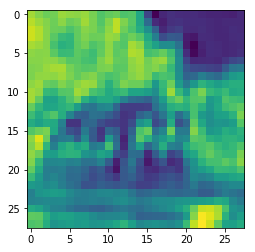
class FirstCNN_v3(nn.Module):
def __init__(self):
super(FirstCNN_v3, self).__init__()
self.model = nn.Sequential(
nn.Conv2d(3, 6, 5), # (N, 3, 32, 32) -> (N, 6, 28, 28)
nn.AvgPool2d(2, stride=2), # (N, 6, 28, 28) -> (N, 6, 14, 14)
nn.Conv2d(6, 16, 5), # (N, 6, 14, 14) -> (N, 16, 10, 10)
nn.AvgPool2d(2, stride=2) # (N, 16, 10, 10) -> (N, 16, 5, 5)
)
def forward(self, x):
x = self.model(x)
return x
net = FirstCNN_v3()
out = net(images)
out.shape
Output:
torch.Size([4, 16, 5, 5])
plt.imshow(out[0, 0, :, :].detach().numpy())
Output:
<matplotlib.image.AxesImage at 0x7fa818be2400>
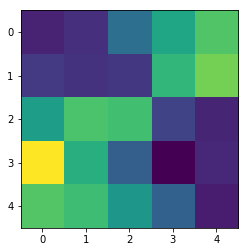
LeNet
class LeNet(nn.Module):
def __init__(self):
super(LeNet, self).__init__()
self.cnn_model = nn.Sequential(
nn.Conv2d(3, 6, 5), # (N, 3, 32, 32) -> (N, 6, 28, 28)
nn.Tanh(),
nn.AvgPool2d(2, stride=2), # (N, 6, 28, 28) -> (N, 6, 14, 14)
nn.Conv2d(6, 16, 5), # (N, 6, 14, 14) -> (N, 16, 10, 10)
nn.Tanh(),
nn.AvgPool2d(2, stride=2) # (N,16, 10, 10) -> (N, 16, 5, 5)
)
self.fc_model = nn.Sequential(
nn.Linear(400,120), # (N, 400) -> (N, 120)
nn.Tanh(),
nn.Linear(120,84), # (N, 120) -> (N, 84)
nn.Tanh(),
nn.Linear(84,10) # (N, 84) -> (N, 10)
)
def forward(self, x):
print(x.shape)
x = self.cnn_model(x)
print(x.shape)
x = x.view(x.size(0), -1)
print(x.shape)
x = self.fc_model(x)
print(x.shape)
return x
net = LeNet()
out = net(images)
Output:
torch.Size([4, 3, 32, 32])
torch.Size([4, 16, 5, 5])
torch.Size([4, 400])
torch.Size([4, 10])
print(out)
Output:
tensor([[ 0.0818, 0.0688, -0.0482, -0.1218, -0.1274, -0.0431, 0.1100, 0.0679,
0.0587, -0.1229],
[ 0.0884, 0.0577, -0.0446, -0.1189, -0.1232, -0.0427, 0.1160, 0.0535,
0.0494, -0.1148],
[ 0.0672, 0.0677, -0.0417, -0.1379, -0.1311, -0.0554, 0.1107, 0.0425,
0.0451, -0.1298],
[ 0.0750, 0.0620, -0.0458, -0.1272, -0.1160, -0.0595, 0.1157, 0.0523,
0.0496, -0.1173]], grad_fn=<AddmmBackward>)
max_values, pred_class = torch.max(out.data, 1)
print(pred_class)
Output:
tensor([6, 6, 6, 6])
Training LeNet
class LeNet(nn.Module):
def __init__(self):
super(LeNet, self).__init__()
self.cnn_model = nn.Sequential(
nn.Conv2d(3, 6, 5), # (N, 3, 32, 32) -> (N, 6, 28, 28)
nn.Tanh(),
nn.AvgPool2d(2, stride=2), # (N, 6, 28, 28) -> (N, 6, 14, 14)
nn.Conv2d(6, 16, 5), # (N, 6, 14, 14) -> (N, 16, 10, 10)
nn.Tanh(),
nn.AvgPool2d(2, stride=2) # (N,16, 10, 10) -> (N, 16, 5, 5)
)
self.fc_model = nn.Sequential(
nn.Linear(400,120), # (N, 400) -> (N, 120)
nn.Tanh(),
nn.Linear(120,84), # (N, 120) -> (N, 84)
nn.Tanh(),
nn.Linear(84,10) # (N, 84) -> (N, 10)
)
def forward(self, x):
x = self.cnn_model(x)
x = x.view(x.size(0), -1)
x = self.fc_model(x)
return x
batch_size = 128
trainset = torchvision.datasets.CIFAR10(root='./data', train=True, download=True, transform=transforms.ToTensor())
trainloader = torch.utils.data.DataLoader(trainset, batch_size=batch_size, shuffle=True)
testset = torchvision.datasets.CIFAR10(root='./data', train=False, download=True, transform=transforms.ToTensor())
testloader = torch.utils.data.DataLoader(testset, batch_size=batch_size, shuffle=False)
Output:
Files already downloaded and verified
Files already downloaded and verified
def evaluation(dataloader):
total, correct = 0, 0
for data in dataloader:
inputs, labels = data
outputs = net(inputs)
_, pred = torch.max(outputs.data, 1)
total += labels.size(0)
correct += (pred == labels).sum().item()
return 100 * correct / total
net = LeNet()
import torch.optim as optim
loss_fn = nn.CrossEntropyLoss()
opt = optim.Adam(net.parameters())
%%time
loss_arr = []
loss_epoch_arr = []
max_epochs = 16
for epoch in range(max_epochs):
for i, data in enumerate(trainloader, 0):
inputs, labels = data
opt.zero_grad()
outputs = net(inputs)
loss = loss_fn(outputs, labels)
loss.backward()
opt.step()
loss_arr.append(loss.item())
loss_epoch_arr.append(loss.item())
print('Epoch: %d/%d, Test acc: %0.2f, Train acc: %0.2f' % (epoch, max_epochs, evaluation(testloader), evaluation(trainloader)))
plt.plot(loss_epoch_arr)
plt.show()
Output:
Epoch: 0/16, Test acc: 38.39, Train acc: 38.13
Epoch: 1/16, Test acc: 43.67, Train acc: 43.74
Epoch: 2/16, Test acc: 46.30, Train acc: 46.62
Epoch: 3/16, Test acc: 49.37, Train acc: 50.37
Epoch: 4/16, Test acc: 50.15, Train acc: 51.86
Epoch: 5/16, Test acc: 52.14, Train acc: 54.40
Epoch: 6/16, Test acc: 52.72, Train acc: 56.28
Epoch: 7/16, Test acc: 53.53, Train acc: 57.73
Epoch: 8/16, Test acc: 54.44, Train acc: 58.82
Epoch: 9/16, Test acc: 54.61, Train acc: 59.97
Epoch: 10/16, Test acc: 55.91, Train acc: 61.58
Epoch: 11/16, Test acc: 55.41, Train acc: 61.88
Epoch: 12/16, Test acc: 55.28, Train acc: 63.09
Epoch: 13/16, Test acc: 56.54, Train acc: 64.56
Epoch: 14/16, Test acc: 56.37, Train acc: 64.63
Epoch: 15/16, Test acc: 56.54, Train acc: 66.50
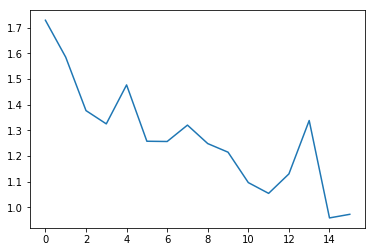
CPU times: user 7min 39s, sys: 9.16 s, total: 7min 48s
Wall time: 7min 49s
Move to GPU
device = torch.device("cuda:0" if torch.cuda.is_available() else "cpu")
print(device)
Output:
cuda:0
def evaluation(dataloader):
total, correct = 0, 0
for data in dataloader:
inputs, labels = data
inputs, labels = inputs.to(device), labels.to(device)
outputs = net(inputs)
_, pred = torch.max(outputs.data, 1)
total += labels.size(0)
correct += (pred == labels).sum().item()
return 100 * correct / total
net = LeNet().to(device)
loss_fn = nn.CrossEntropyLoss()
opt = optim.Adam(net.parameters())
%%time
max_epochs = 16
for epoch in range(max_epochs):
for i, data in enumerate(trainloader, 0):
inputs, labels = data
inputs, labels = inputs.to(device), labels.to(device)
opt.zero_grad()
outputs = net(inputs)
loss = loss_fn(outputs, labels)
loss.backward()
opt.step()
print('Epoch: %d/%d' % (epoch, max_epochs))
Output:
Epoch: 0/16
Epoch: 1/16
Epoch: 2/16
Epoch: 3/16
Epoch: 4/16
Epoch: 5/16
Epoch: 6/16
Epoch: 7/16
Epoch: 8/16
Epoch: 9/16
Epoch: 10/16
Epoch: 11/16
Epoch: 12/16
Epoch: 13/16
Epoch: 14/16
Epoch: 15/16
CPU times: user 1min 37s, sys: 1.97 s, total: 1min 38s
Wall time: 1min 39s
print('Test acc: %0.2f, Train acc: %0.2f' % (evaluation(testloader), evaluation(trainloader)))
Output:
Test acc: 55.23, Train acc: 65.33
Basic Visualisation
imshow(torchvision.utils.make_grid(images))
Output:

net = net.to('cpu')
out = net(images)
print(out.shape)
Output:
torch.Size([4, 10])
out = net.cnn_model[0](images)
out.shape
Output:
torch.Size([4, 6, 28, 28])
image_id = 3
plt.figure(figsize = (2,2))
imshow(images[image_id,])
Output:
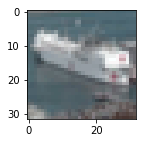
plt.figure(figsize = (6,6))
plt.subplot(321)
for i in range(6):
ax1 = plt.subplot(3, 2, i+1)
plt.imshow(out[image_id, i, :, :].detach().numpy(), cmap="binary")
plt.show()
Output:
/usr/local/lib/python3.6/dist-packages/matplotlib/figure.py:98: MatplotlibDeprecationWarning:
Adding an axes using the same arguments as a previous axes currently reuses the earlier instance. In a future version, a new instance will always be created and returned. Meanwhile, this warning can be suppressed, and the future behavior ensured, by passing a unique label to each axes instance.
"Adding an axes using the same arguments as a previous axes "

Thanks for Reading:) Please share any feedbacks down in the comments 👨💻️.
Btw, New Year is coming !
![happy.new_.year_[1].gif](https://cdn.hashnode.com/res/hashnode/image/upload/v1609426067928/ZhpNzrHOH.gif?auto=format,compress&gif-q=60&format=webm)

